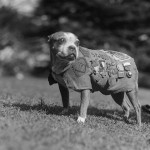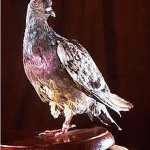Throughout the wars and military campaigns of history, animal helpers devotedly executed their tasks. They had no choice in their service and many thousands perished in their duties.
In today’s guest post by Melissa Russel, we are reminded of the service animals honored for their role in conflict and war.
With his jowly mug and fireplug body, Stubby the pit bull mix wasn’t likely to win many beauty contests. But that was just fine – after all, “Sgt. Stubby” already had his paws full winning military honors.
From finding lost and injured soldiers in “no man’s land” to warning of gas attacks and capturing a German spy, Stubby took part in more than a dozen battles during World War I, surviving wounds and eventually returning from the muddy trenches of France to a hero’s welcome that took him to the White House and beyond.
The stray mutt who was smuggled to the Western Front aboard a troop ship came to be known as the “Grandfather of the American War Dog.” When he passed away in 1926, his obituary in The New York Times began simply, “Stubby is dead.”
Nearly 90 years later, Sgt. Stubby is memorialized in the nation’s capital, where his stuffed body is on display in the National Museum of American History at the Smithsonian. He belongs to a long roster of military animals, four-legged, winged and otherwise, that are often the unsung heroes of conflicts worldwide.
Today, that tradition continues from the rocky shores of America’s Pacific Coast to the dusty mountains of Afghanistan, where U.S. military dogs search for explosive devices and protect against insurgent attacks.
Marine League: Since the 1950s, the U.S. Navy has used marine mammals to patrol the waters in and around ports, harbors and naval facilities, and to search for mines and other submerged dangers. At the Navy’s Marine Mammal Program in San Diego, California, bottlenose dolphins and California sea lions also are trained to locate unauthorized swimmers and recover training equipment.
Fearless Flyers: During both the First and Second World Wars, the Allied Forces used thousands of carrier pigeons to relay coded messages, often across enemy lines and even across the English Channel after the D-Day landings of 1944.
Among the most famous of these feathered fighters was “Cher Ami,” who served as part of the U.S. Army Signal Corps during World War I. Cher Ami, which is French for “dear friend,” was shot during a mission in France but was able to deliver his message, leading to the safe return of nearly 200 American infantrymen trapped in enemy territory.
Cher Ami succumbed to his wounds in 1919. Like his canine counterpart Sgt. Stubby, Cher Ami is on display at the National Museum of American History.
The World War II equivalent of Cher Ami may have been a pigeon named “G.I. Joe,” who was credited with carrying a message 20 miles in 20 minutes, a feat that prevented the mistaken bombing of Allied troops by their own forces.
Real-Life War Horse: The tale of “Sgt. Reckless” grew to become legend in the years after the little horse served with distinction in the Korean War.
According to an account published in the magazine Leatherneck, a U.S. Marine Corps lieutenant paid the princely sum of $250 for the mare in 1952, enlisting her as a rifle platoon packhorse. Over the following months, Reckless saw action in some of the war’s bloodiest battles, transporting loads of munitions dozens of times over countless miles while under fire.
Word of Reckless’ heroism spread far and wide, leading to a celebrated homecoming stateside and a promotion to staff sergeant. By the time of her death in 1968, the mare’s military honors included two Purple Hearts, a Presidential Unit Citation with star and a United Nations Service Medal.
A statue of Sgt. Reckless is scheduled to be dedicated in July 2013 at the National Museum of the Marine Corps in Quantico, Virginia.
The project is one of a number of grassroots efforts nationwide that aim to recognize the horses, dogs and other animals that have served the military. In October 2013, the National Monument for Military Working Dog Teams is set to be dedicated at Lackland Air Force Base in Texas, the primary training site for military dogs and their handlers.
So, as the nation paused on Veterans Day to honor its veterans, many took time to remember the sacrifices of its dedicated military animals.
 Melissa Russell writes on education topics for military and veterans. Her post appears courtesy of the New England College Online resource pages. She also writes on topics such as business administration and corporate sustainability for a number of universities through the University Alliance.
Melissa Russell writes on education topics for military and veterans. Her post appears courtesy of the New England College Online resource pages. She also writes on topics such as business administration and corporate sustainability for a number of universities through the University Alliance.
Below is a 2 minute trailer from the Steven Spielberg movie War Horse.
In upcoming posts we will feature Alex Quade, war reporter who directed the movie; Horse Soldiers of 9/11. The movie documents a unique special forces operation in Afghanistan.


Speak Your Mind